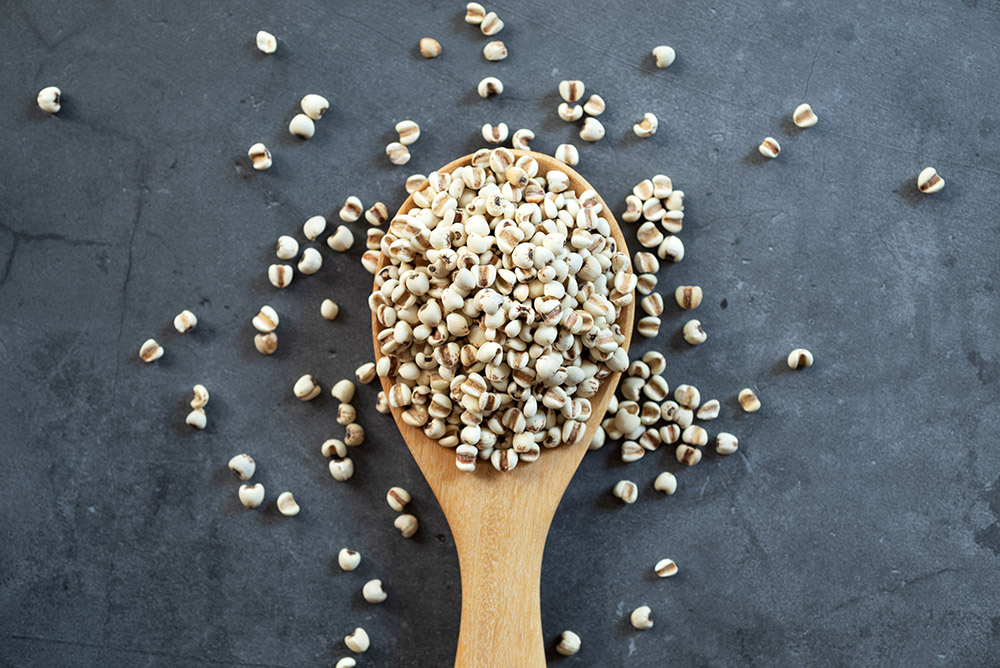Coix as Food: An Underutilized and Interesting Medicinal Food

by Michael Tierra
“Let your medicine be your food and your food, your medicine.” The sovereign dictum of Hippocrates is aptly epitomized by the use of Coix (Coix lacrymi-jobi, also known as Job’s tears and yi yi ren) as the most common treatment for cancer in China.
Coix is a member of the Graminaceae family of which all grains are a member. In China and throughout Asia, this little known, non-glutenous grain obtained by removing the hard husk of the fruit is widely used both as a food and for medicine. As a food it is densely nutritious.
Per 100 grams, these seeds contain approximately:
- 7 percent fat
- 18 percent protein
- 52 percent starch
- protein – 15.4 g
- dietary fiber – 3g
- Ca – 25 mg
- Fe – 5 mg
- Vitamin B1 – 0.28 mg
- Vitamin B2 – 0.19 mg
- Niacin – 4.3 mg
BIOACTIVE CONSTITUENTS IN COIX
The oil in coix (coixol) which is 5-7% of the dried seed is antispasmodic, partially accounting for its use in the treatment of arthritic and rheumatic conditions. Coix is highly touted benefit for clearing the skin of blemishes, warts, eczema and generally clearing and softening the skin. For these indications it is used both internally and applied externally as a cream or ointment.
The second major constituent, coixelide, at only 0.25% is thought to account for its anti-inflammatory and anticancer properties.
The bioactive constituents of coix seeds include polysaccharides, proteins, lipids, polyphenols, phytosterols, carotenoids, spironone and lactams. Spironone (Spironolactone) is a potassium-sparing and thiazide diuretic combination used to treat high blood pressure and swelling due to excess body water. Lactam further contributes to the elimination of excess intramolecular fluid and has anti-inflammatory and antipathogenic properties.
These constituents together offer a wide range of medical and nutritional benefits which include anti-oxidation, anti-cancer, anti-inflammation, anti-allergy, enhancing immunological activity, regulating endocrine functions, anti-obesity, anti-diabetes, gastroprotection, hypolipidemia, and modulating gut microbiota. Coix exhibits all of these properties.

COIX AS FOOD
Its flavor and texture is sweet-ish, bland and somewhat chewy. It is gluten-free, high in protein and starch, and together with its other constituents should be a welcome addition for a weight loss diet and for individuals afflicted with celiac disease or gluten intolerance.
Because of its diuretic action, it is not recommended for use during pregnancy. Because of its effective blood-sugar-lowering, hypoglycemic properties, it should be used with caution for those who are taking diabetic medication. In general, it is contraindicated for people with a yin deficient dry constitution.
Coix grain combines well with rice or oatmeal and can be added to soups and stews. One can find numerous recipes on the internet.[1] Following are the most basic instructions for preparing coix:
- Rinse 1 cup dried coix in a colander.
- Add rinsed coix in a pot and add enough water to cover.
- Bring to a boil then reduce the heat to a slow simmer.
- When tender, drain the coix and serve.
COIX AS MEDICINE
TCM classifies yi yi ren as having a blandly sweet flavor and a cool (anti-inflammatory) energy. Its bland flavor signals its diuretic action and the sweet flavor its effect on digestion and assimilation. Thus, TCM designates that it has special effect on the TCM Spleen, Stomach, Lung and Large Intestine organ-meridians.
As a medicine, coix has many applications. The major one is its ability to clear extra interstitial fluid (dampness in TCM) from the body. Dampness is caused by overeating, excess sugar, and low metabolism that increases with age.
Dampness, when not efficiently drained, congeals, eventually causing phlegm and an acute chronic inflammatory condition called damp-heat. Damp-heat is an inflammatory condition that occurs with many disease complexes, ranging from the appearance of infective discharges of pus to yellow phlegm, leucorrhea, and arthritic conditions including rheumatoid arthritis for which coix is indicated.
Fat and obesity are an obvious sign of dampness. With the U.S. being home to the highest number of overweight and obese people in the world (70.9 percent of men, 61.9 percent of women are overweight or obese, compared to 38 percent of men and 36.9 percent of women worldwide), it is no wonder that so many tend to lower immunity and chronic degenerative disease.
TCM views dampness as a pathogenic factor associated with diseases such as high cholesterol, cardiovascular disease, digestive disease, metabolic disorders, cancer, chronic fatigue syndrome, multiple sclerosis, fibromyalgia, arthritic and rheumatic diseases, eczema, allergies, and environmental illness.
Dampness and its consequence Phlegm, another pathogenic factor in TCM, cause stagnation of circulation. Since the lowering of metabolism is a consequence of aging, as we get older, everyone tends to accumulate dampness. Coix along with guggul (Commiphora mukul) are among the two major botanicals to eliminate ama, described in Ayurveda as toxic residue left behind from poorly digested from food.
COIX AND CANCER
Dampness and inflammation are associated with many chronic degenerative diseases including cancer. While with improved early diagnosis and cancer therapies there has been in an overall decline of 29% fewer cancer deaths, [2] cancer still remains as the second major cause of death in the U.S. after heart disease, with 1,220 deaths per day in 2020. [3] The exorbitant costs of conventional medical treatments for cancer motivate informed patients to seek and find benefit from integrative care with alternative non-invasive approaches such as lifestyle, diet, herbs and acupuncture.
The antineoplastic action of coix and coixenolide was utilized in a famous anti-cancer formula known as WTTC by Yoshima Okusa, a Japanese physician. WTTC is based on the initials of the formula ingredients: Chinese wisteria seed[4], trapa (water chestnut), Terminalia and coix.
- Wisteria seed is toxic. Its use in Traditional Chinese medicine is based on its being prepared and dosed to minimize its toxicity. It has a cool anti-inflammatory energy. It is probably the combination of its diuretic and somewhat diminished toxicity that makes it effective for the treatment of cancer.
- Trapa or Chinese water chestnut is a delicious botanical used medicinally and as a confection in China. It is cold in nature, sweet in taste and acts on the Lungs and Stomach organ meridians. It clears heat, relieves indigestion, promotes urination, relieves hypertension, cures sore throat and hemorrhoids, stops coughing, and clears phlegm.
- Terminalia probably refers to chebula known as he zi. It is one of the three ingredients in the famous Ayurvedic detoxifying compound known as triphala. It is cold in nature and especially used for chronic diarrhea and dysentery caused by deficiency-cold.
- Coix has anticancer, anti-inflammatory and diuretic properties as described earlier in this article.
From the above ingredients we see that WTTC is indicated for cancer of the stomach and intestines (especially colorectal cancer) although many have come to use, probably misuse it generally for all cancers. However, considering the adverse effects of conventional Western cancer treatments on the digestive system, we see how, while not a cancer cure-all, it imparts a protective and preventive benefit for the GI tract when used in combination with surgery, radiotherapy and chemotherapy.
A day’s therapeutic dose of coix ranges from 16 to 32 grams or more daily, used singly or as part of a formulation. It is widely used in China, Japan and other Asian countries as foodhaving a reputation that in areas where it is regularly consumed there may be a notably lower incidence of cancer.
An anticancer pharmaceutical made from Coix seed oil, called Kanglaite, has proven effective in treating multiple types of cancers in China. As a pharmaceutical it is used as an injection.[5]
Kanglaite can be used for the treatment of:
- chorioepithelioma (a fast-growing tumor which develops from trophoblastic cells)
- ovarian cancer
- lung cancer
- digestive tract cancer
The mechanism of action of Klangaite is as follows:
- reverses the multi-resistance of tumor cells to anticancer drugs
- counteracts the cachexia of cancers
- inhibits the tumor angiogenesis
- affects the genetic expression of tumor cells by up-regulating FAS/Apo-1 gene expression
- induces apoptosis of tumor cells
- inhibits the mitosis of tumor cells during G2/M phases
ASCITES:
This is a condition that commonly occurs secondary to liver cirrhosis.
Red kidney beans: 30 grams
Coix: 30 grams
Polished round-grained rice: 30 grams
Tangerine peel (chenpi): 3 grams
These ingredients are to be boiled to make a gruel that is taken in two meals during the day.
The combination of coix with aduki beans is a good combination for clearing excess water from the interstitial spaces of the body.
ENLARGED PROSTATE
A combination especially useful for edema, constipation and easing urination attendant to prostatic hypertrophy is a porridge made of coix with crushed prune seed (yuliren).
CACHEXIA AND WASTING
Cachexia or wasting occurs in the final stages of cancer and it is a challenge to supply high quality nutrition to cachexia patients. In fact, most patients don’t die directly from cancer but from cachexia or severe wasting. It is as if the cancer gradually gobbles up the nutrients of the body for its own growth. For that reason, it is important to keep a record of any significant loss of weight occurring with cancer patients.
The following medicinal soup, which is a slightly modified version of the famous Chinese Four Herbs Soup (Si Shen Tang) used to strengthen the TCM Spleen and the digestive system and improve poor appetite[6] is given to patients suffering from cachexia attendant to cancer and all other wasting diseases.
- 9 g Dioscorea (shan yao)
- 9 g Poria cocos (fu ling) mushroom
- 6-9 g euyrale seeds (fox nut)
- 6-9 g lotus seeds
- 16-30 g coix
- pork or beef as desired
UTERINE FIBROIDS AND TO INVIGORATE BLOOD CIRCULATION:
Combine 500 g coix with 150 g sanqi ginseng (Panax notoginseng) and grind them to a powder. Take 15 g three times daily (equivalent to 34 g of coix and 11 g of sanqi). This combination was given for the treatment of uterine fibroids, a condition of damp and blood stagnation. Tien-qi inhibits bleeding while vitalizing blood circulation.
OTHER TIDBITS ABOUT COIX
Based on the appearance of the seed pod resembling tears, coix is commonly called “Job’s tears,” referring to the Bible passage in the Book of Job, “before my eyes drop tears.”
It is easily grown but the task of removing the outer husk for use as food and medicine is one that most are not equipped to do. The whole unhusked seed pods, called pericarps, which have a naturally occurring hole at each end, are resistant to moisture and were called “corn beads” and strung into a necklace by the Cherokee for personal adornment. They are also used for making necklaces and rosaries by Europeans who dubbed them “Mary’s Tears.”
I hope that this introduction inspires many more to integrate coix into your lives as medicine, food and even as ornaments. Coix would be a wonderful regular addition to our diet. It is available for growing and as food or medicine from many online suppliers.
Learn more about food as medicine in our Home Herbalist Course.
[1] Sites that have interesting coix recipes:
https://www.101cookbooks.com/archives/jobs-tears-you-need-to-check-out-this-power-ingredient-recipe.html
https://www.bonappetit.com/entertaining-style/trends-news/article/jobs-tears-grain-recipes
https://www.hwcmagazine.com/recipe/how-to-cook-tasty-gluten-free-jobs-tears/
[2] https://acsjournals.onlinelibrary.wiley.com/doi/epdf/10.3322/caac.21590
[3] https://www.cancer.org/latest-news/facts-and-figures-2020.html
[4] Wisteria seed is toxic. It’s use in Traditional Chinese medicine is based on its being prepared and dosed to minimize its toxicity. It is probably the combination of its diuretic and somewhat detoxified toxicity that makes it effective for the treatment of cancer.
[5] https://pubmed.ncbi.nlm.nih.gov/18087221/
[6] https://souperdiaries.com/four-herbs-soup/






Responses